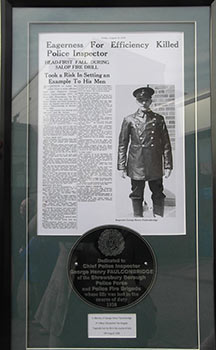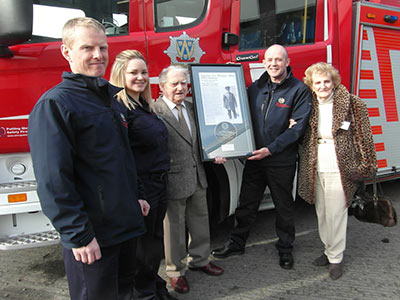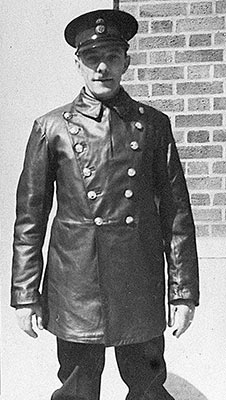
Firefighters and staff from Shropshire Fire and Rescue Service have paid tribute to the only fireman known to have died on duty in Shropshire.
George Faulconbridge (50) fell to his death during a fire drill in Shrewsbury in 1938 while demonstrating how people could be lowered to safety in a hoist. He lost his grip on a rope and died in front of his firefighting colleagues after the 26ft fall.
His death could have been forgotten but for the determination of three staff members who “went on the history trail” to collect information which resulted in a large family reunion at a ceremony held at Shrewsbury fire HQ.

A newspaper cutting about the tragedy and a copy of a plaque in the national arboretum make up the tribute to Inspector George Faulconbridge to be displayed at the Shropshire fire station.
Two of George Faulconbridge’s surviving children, Robert (89) and Marjorie (82) along with their children and grandchildren gathered at Shrewsbury fire HQ to hear a tribute from Chief Fire Officer Paul Raymond.
He told them it was a very important day to reunite the Faulconbridge generations with the fire service family and to ensure that their ancestor’s memory “was never lost.”
Their father’s death was “a tragic end” to a life of loyal service which included being an Army Sergeant, Police Inspector, Coroner’s Officer and second officer in charge of Shrewsbury Fire Brigade.
“The only reason he died was because he wanted to demonstrate to his firefighters how to stay safe. George Faulconbridge helped to shape the service, which became Shropshire Fire and Rescue Service. We will remember him,” said Mr Raymond.
Born in Birmingham, the son of a railway stoker, George was brought up by a cousin when his mother died when he was just three years old. At 13 he was enlisted in the Army training school as a wheelright.
A First World War survivor, he took part in the retreat from Mons and was an artillery “spotter”– renowned as one of the most dangerous positions in the Royal Army Ordnance Corps.
George re-joined Shrewsbury Borough Police Force and in January 1938 he looked after the VIP visit to Shrewsbury from Haile Selassie – even taking him to his barber’s after the Ethiopian Emperor praised the police officer’s smart appearance.
His son Robert, of Cruckmeole, Hanwood, recalled how his father who wasn’t “the sort of man to get excited” was “bubbling” when he came home and got everyone to shake his hand before he washed it because he had shaken hands with the great Haile Selassie.
A quiet but “driven” man, George Faulconbridge was an enthusiastic member of the new Shrewsbury Police and Fire Brigade when most fires were in haystacks and took days and nights to put out.
The father of four was eager for efficiency and had demonstrated fire drills for more than eleven years before that fateful day on August 24, 1938. He was at the new fire station in Cross Hill explaining how the Davy Descender lowered a person using a geared braking mechanism to control the descent.
One of the men in the drill yard asked: “could two men come down on it?” to which Inspector Faulconbridge, who was eager to train his men and set a good example fatefully replied: “yes, I will show you.”
He climbed a ladder where Fireman Jones had attached the Davy sling under his arms. Holding onto his shoulders, Inspector Faulconbridge and his colleague let go of the ladder and quickly dropped 6ft – when suddenly the rope jerked, George Faulconbridge lost his grip and plunged to the ground. He died later that day in Royal Salop Infirmary.
Chief Constable Frank Davies told the inquest that he was a loyal and efficient officer whose “eagerness” to make them more efficient had cost him his life.
Teenage son Robert Faulconbridge and his elder brother left school to work at Chatwood safe factory at Harlescott, Shrewsbury. He said they had to leave their police home within two weeks and his mother only received a reduced Sergeant’s pension as her husband had been on fire and not police duty when he died.
Mr Faulconbridge, who still lives in the Shrewsbury area, met firefighters during a routine home fire safety visit when he told them about his father’s service decades earlier. Temporary crew manager Katy Lowe, who was already investigating the history of Shropshire Fire and Rescue Service then took up the search for information on the forgotten sacrifice of George Faulconbridge.

On the history trail: Katy Lowe, temporary fire control crew manager with firefighters Ollie Dregorne and Neil Grady who ensured that the sacrifice of Inspector George Faulconbridge would never be forgotten. They are pictured with Robert Faulconbridge and his sister Marjorie Andrews

Inspector George Faulconbridge







